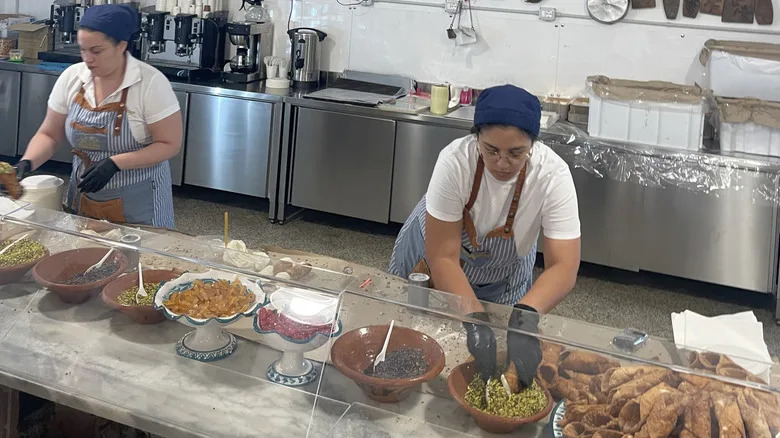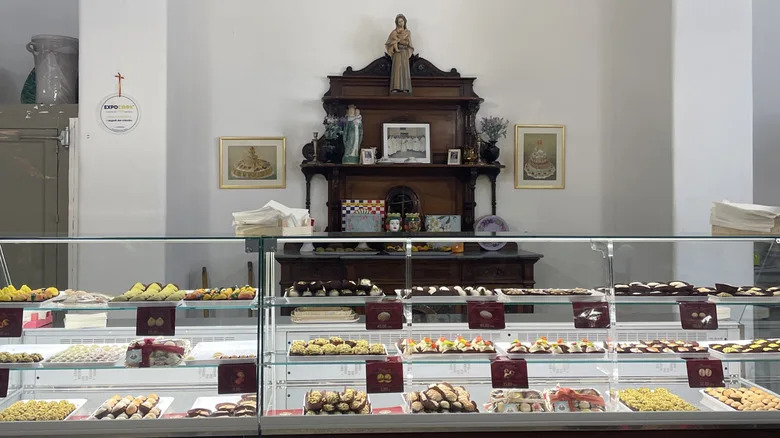People are always in search of the very best things to eat when they travel, especially when visiting somewhere with a food scene as iconic as Italy’s. Big plates of buttery ravioli, giant slices of oozing lasagne, freshly made cones topped with creamy scoops of gelato –- the list of Italian delicacies to get through is never ending. But if you’re looking for the perfect cannoli, then we can point you in the right direction: a historic monastery in Sicily’s capital.
Tucked down the echoing halls of Santa Caterina d’Alessandria in Palermo is a tiny, emblem-covered room where local pastry chefs pump out countless fresh cannoli, cakes, and cookies every day. The bakery or “dolceria” is part of a project called “I Segreti del Chiostro”, which translates to “The Secrets of the Cloister.” Many of Sicily’s signature desserts can be traced back to cloistered nuns, who would sell sweets to aristocracy to support their monasteries. This was the case at Santa Caterina from 1311 all the way up until the 1980s, a few decades before the last nuns moved out.
The aim of I Segreti del Chiostro is to recreate the recipes of those women and keep their time-honored baking traditions alive. Everything is made fresh using ancient recipes and techniques. The bakery has become world famous since it re-opened its doors in 2019, attracting tourists, pastry chefs, and social media stars alike to try the bakery’s famous cannoli.
Read more: 10 Mistakes To Avoid When Dining In Italy
A traditional Sicilian cannoli
Two women man the cannoli station at I Segreti del Chiostro – Martha Brennan/Tasting Table
When you finally make your way through the line at I Segreti del Chiostro, you’ll be faced with two long counters that wrap the small room in an L-shape. This is the cannoli-making station, where multiple pastry chefs stand in a line behind towering plates of crisp, golden pastry shells and bowls of toppings like crushed pistachios, chocolate chips, and strips of candied orange. The women pipe and sugar the cannoli with military speed and precision, and the end product is a ginormous, drool-worthy dessert you can enjoy in the charming courtyard nearby.
The surroundings are as simple as the ingredients — everything in the confectionery has been preserved, from the religious iconography and marble counters to the vintage weighing scales and cookware. I Segreti del Chiostro prides itself at keeping modern technology out. It still uses the old wood-fired and gas ovens that were once manned by the nuns, and the only piece of new equipment is a mechanical dough roller. The result? Traditional Sicilian cannoli that more than live up to the hype, especially the homemade pistachio cannoli.
What to get at I Segreti del Chiostro
Confectionary on display on at I Segreti del Chiostro – Martha Brennan/Tasting Table
I sampled a chocolate chip and pistachio cannoli on a recent visit, and was blown away by both. The shell shattered upon the first bite, and the ricotta filling was perfectly creamy and balanced. It tasted light but decadent at the same time, with the orange peel providing the perfect zing to compliment the rich flavors. Everyone who was scattered across the courtyard was eating in a similar stunned silence, whether they were enjoying the cannoli or other must-try sweets like an almond and pistachio cake, Sicilian cassata, or biscotti ricci.
What’s special about being able to taste these confections today is that even locals weren’t always able to obtain them back in the day. The recipes were kept top secret, and usually only the wealthy could afford to buy the pastries due to the high costs of the ingredients. Though the recipes have since been published, we still don’t know exactly what it is that sets I Segreti del Chiostro apart. Some pinpoint the use of local sheep milk in the filling, or the fact that the shells are fried in lard. It’s probably just all of the care that goes into making each one — or maybe it’s some blessing that’s been passed on. In any case, these nuns were definitely doing something right.
Want more food knowledge? Sign up to our free newsletter where we’re helping thousands of foodies, like you, become culinary masters, one email at a time.
Read the original article on Tasting Table.


Dining and Cooking